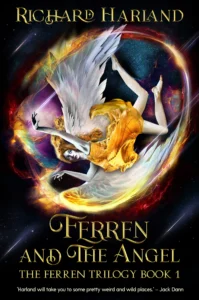About Ferren and the Angel by Richard Harland

Ferren and the Angel is YA fantasy, a retro-future dystopia where the armies of Earth battle against the armies of Heaven. It begins when an angel falls from the sky and crashes to the Earth …
The setting is the far future, a thousand years after human scientists started to explore life after death, discovered the reality Heaven and ended up waging war against the angels. Now the artificially created ‘Humen’ make up Earth’s military forces, while the original human beings have been reduced to a degraded existence living in fearful, isolated tribes.
While the Humen are preparing for their ultimate invasion of Heaven, the angel Miriael is shot down and falls to the Earth. Damaged and unable to fly, she prays for extinction.
A young tribesman, Ferren, finds her lying in the grass. She ought to be an enemy, since his people think of themselves as allies with the Humen, on the side of the Earth. But his curiosity and pity outweigh every rule of his upbringing.
He knows almost nothing about the world he’s grown up in. Now he’s going to learn about the Humen Camp and the horrific fate of those tribespeople selected by the Humen for so-called ‘military service. He will be driven into exile, discover the Morphs (or souls no longer allowed into Heaven), break into the Humen Camp, then return to his tribe to warn them of a tremendous battle about to be fought over their territory. Only with Miriael’s help can he build a shelter to protect them from the terrifying psychic and spiritual forces about to be unleashed.
His unique friendship with an angel will change the course of history …
The book draws on the Judeo-Christian-Islamic lore of angelology. But it’s not in any way a religious book, neither pushing a pro-religion message like C.S. Lewis, nor an anti-religion message like Philip Pullman. The closest books in mood and scope are The Farthest Shore, by Ursula le Guin, Sabriel and its sequels by Garth Nix, and – excluding the anti-religion message – Pullman’s His Dark Materials.
Ferren and the Angel Review
I was compensated for my time reading the book and writing this review. However, all thoughts and opinions expressed are my own and are based on my honest personal experience reading the book. Nor did the author in any way shape or form ever pressure me to give a positive review.
Ferren and the Angel by Richard Harland takes readers on a journey through a unique blend of genres, offering a richly layered narrative that seamlessly melds young adult fantasy, retro-future dystopia, and mythology. At its core, it’s a story of grandeur and ambition, with a plot that centers around an ongoing war between Heaven and Earth, a thousand years into the future.
The story begins when an angel, Miriael, falls from the sky, setting in motion a series of events that will forever alter the course of history. The Earth is now inhabited by “Humen,” artificially created beings who serve as the military force, while the original humans live in isolated, fearful tribes. It’s within this intricate and beautifully imagined world that a young tribesman, Ferren, discovers the fallen angel. And that’s where the story begins.
The writing style initially caught me off guard since it didn’t quite align with most of the YA high fantasy books I’ve been reading these days. It leaned toward the dramatic, reminiscent of the older fantasy epics I encountered during my high school English classes. To be fair, I primarily indulge in more “blockbuster” fantasy young adult and new adult literature published by authors like Sarah J. Maas, Holly Black, and more (if you know you know, that type of mainstream YA/NA fantasy writing style). So if Ferren and Angel‘s writing style sounds like it is more to your liking, then you’ll enjoy it.
Another thing that caught my attention from page 1 was the very common use of onomatopoeia. It was quite prominent, though thankfully it did tone down a bit as the book progressed. Some authors prefer more visual descriptions for visualization when writing their books, and it seems like Harland’s is more auditory. Though it did undeniably aid in visualizations while also contributing to the overall dramatic and old-school tone. So from that perspective, the use of onomatopoeia fits well with the style of Ferren and the Angel that Harland is setting up. It’s interesting that despite its intended young adult audience, the writing style felt more vintage in its attempt to sound youthful.
The brevity of the chapters in Ferren and the Angel though is an unexpected departure from the conventions typically associated with high fantasy literature. Within this genre, lengthy and immersive chapters are a common hallmark, serving to intricately establish rich, otherworldly settings and elaborate narratives. However, in Harland’s work, the notably concise chapter structure contributes to accelerated pacing, particularly evident when transitioning between points of view, such as those of the protagonists, Ferren and Miriael.
This brevity, while potentially beneficial in the mid-to-late segments of the narrative once readers are more acclimated to the world, poses a challenge in the opening chapters. High fantasy, by nature, introduces unfamiliar settings and original world orders. This is why a popular joke within the YA/NA fantasy reading community is that the beginning of every fantasy book is always like gibberish. The rapid pacing during this early phase can impede readers’ comprehension of the narrative’s unfolding events and the nuances of character development and relationships.
This one is especially sad to me because I have interviewed the author before this, and I can see from the interview what he was planning to do. And it’s honestly amazing. Take a look:
“Your protagonist, Ferren, forms a remarkable friendship with an angel, Miriael. Can you delve into the deeper significance of this relationship within the story and the evolution of these characters as a result?
I suppose it has all the clashes and collisions of a mismatched buddy story in a cop drama! Only in this case, it’s the ultimate mismatch – between a being of pure spirit and a fifteen-year-old boy who’s grown up in a very backward, very Earth-bound society. Ferren’s tribe are the very opposite of spiritual: beaten-down and degraded, leading a very physical kind of existence, mere food and survival.
To begin with, Ferren is terrified of the angel and her powers, while Miriael despises him as a low form of life. They’re also officially enemies since Ferren and his tribe think of themselves as allied to the ‘Humen’ on the side of the Earth. But Ferren has curiosity and courage, setting him apart from other members of his tribe, and eventually Miriael learns to appreciate his qualities as an individual and drops her cool superiority.
It’s a unique friendship because normally angels can’t survive in the terrestrial atmosphere without their protective auras. Miriael has not only lost her aura, she’s also been fed food and drink by Ferren when she was lying unconscious. No longer a being of pure spirit, she’s forced to expand her attitudes beyond the highly ethical but very rigid perspective of her training in Heaven. At the same time, she expands Ferren’s mind with a million facts he never knew about the world he lives in.
Nevertheless, it is impossible to overlook the unwavering originality and the audacious aspirations underpinning the world-building in Ferren and the Angel. The author’s adept fusion of steampunk and science fiction influences with the intricate tapestry of Judeo-Christian-Islamic angelology is genuinely remarkable. While my familiarity with the author’s perspective thanks to our interview may have contributed to my appreciation, the sheer passion and devotion invested in this literary work is unmistakable.
Ferren and the Angel are without an ounce of doubt, a work of love. A passion project. For that reason alone, it deserves earnest consideration by readers seeking a unique and thought-provoking narrative.
This book is honestly so rich with a multitude of layers. I have a hunch that a second read, with a bit of adjustment to the unique writing style that was somewhat out of my comfort zone, might make me appreciate it even more. The narrative goes beyond the surface, exploring a multitude of themes, including dreams and inspiration, the chaotic dance of war and conflict, the infusion of mythology and angelology, the blossoming of unlikely friendships and alliances, and the unwavering loyalty that binds the characters together.
I believe if I were to re-read the book again but focus on a different theme each time, it’d be like reading the same book again but from a different perspective. That’s how many layers the worldbuilding and the story have.
I think Harland achieved his goal with this book to the best of his abilities:
I’d hope that readers would be deeply stirred by the grandeur of the mythical themes, continuing from past tradition into Ferren’s present day.”
Ferren and the Angel isn’t just a book – it’s a work with a heart and soul. That’s why, despite some of the issues I mentioned earlier, I’m giving it a solid four-star rating. In the end, it was a pretty darn good read!
If you liked this review and want to see other book reviews like this one, check out my book reviews collection! And if you are interested in learning about the book from the author himself, please check out this interview here too.

